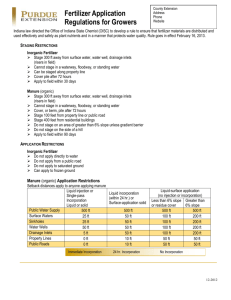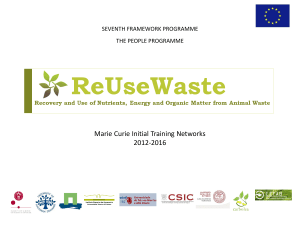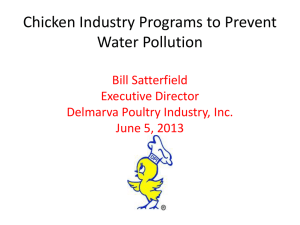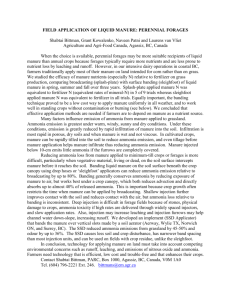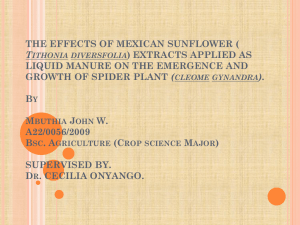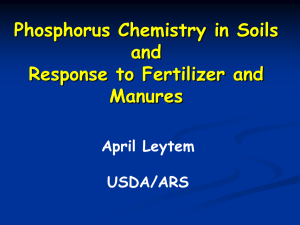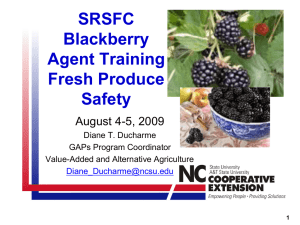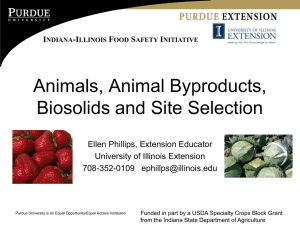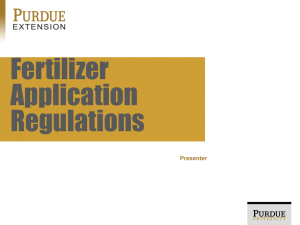Manure Handling on and Near Produce Farms
advertisement
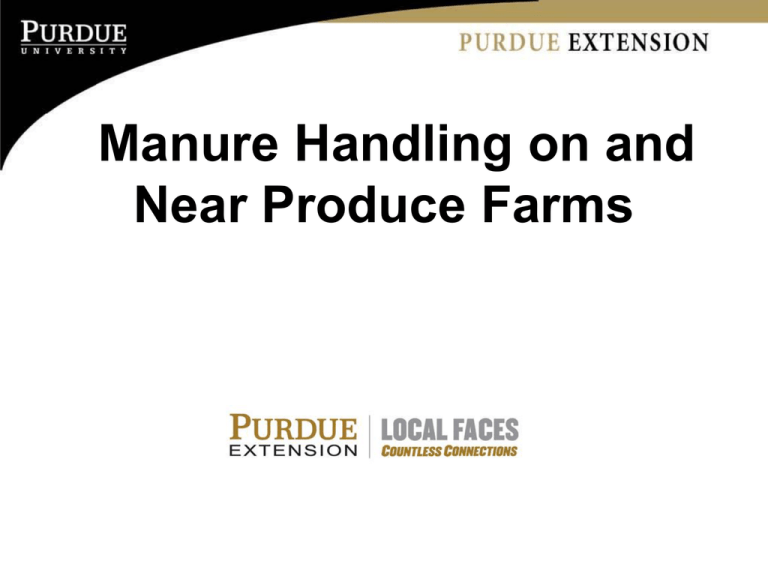
Manure Handling on and Near Produce Farms Why is This a Concern? Every year about one in six Americans, or 48 million people get sick each year from something they eat • 128,000 hospitalizations • 3,000 deaths Causes of illness in 1,565 single food commodity outbreaks, 2003–2008. Source: US Centers for Disease Control. www.cdc.gov/foodborneburden Recent Examples Cantaloupes, August 2012 Cantaloupes, Fall 2011 24 states 28 states 261 Salmonella infections, 3 deaths 147 Listeria infections, 33 deaths Raw produce, May-Aug., 2008 43 states, D.C., Canada Spinach Aug 2007 8,000 cartons of fresh spinach recalled. 1442 Salmonella infections, 286 hospitalized, possible role in 2 deaths No illnesses Fresh spinach, 2006 26 states 200 E. coli O157:H7 infections, 102 hospitalizations, 3 deaths Manure Implicated in a Number of Outbreaks 1981 Cabbage: Listeria was traced to grower who applied manure from sheep herd with history of listeriosis. 2006 Spinach: E. coli 0157:H7 traced to farm leasing land from cattle ranch. 2006 Lettuce: E. coli 0157:H7 outbreak suspected to originate with manure seepage from neighboring dairy farm. 2011 Colorado: Listeria outbreak. Truck hauling culls to local feedlot implicated as possible vehicle for introducing pathogen. Where can Pathogens be Found? Soil People Water Manure Livestock Pets Wildlife All Manure Can Carry Pathogens • Livestock cattle, swine, poultry, horse, & sheep • Dog and Cat • Bird • Rodent • Deer • Fly or other insect • Human Cornell GAPS Pathogens That Cause Foodborne Illness Bacteria – Single-celled organisms that live independently. Viruses – Small particles that live and can only replicate in a host. Parasites – Intestinal worms or microscopic protozoa that live in a host animal or human. Bacteria in human and animal gut… – Salmonella species – E. coli O157:H7 – Shigella species – Campylobacter jejuni Good Agricultural Practices GAPS are the conditions, growing practices, and harvest and postharvest practices recommended to produce safe and wholesome fruits and vegetables. Buyers demand that fruit and vegetable growers follow GAPs and pass an audit by an independent auditor. GAPs Awareness and Training On-Farm Risk Assessment Written Farm Food Safety Plan Plan Implementation Third Party Audit $$$ Certification Manure = Fecal Matter = Microbes • Human or animal: DO EVERYTHING you can to keep manure off produce. • Preventing contamination is the goal. How do pathogens get into produce? Why can’t I just wash my produce? How do Pathogens Get On/In the Produce? From soil, water, animals To roots, leaves, stems, fruit Surface Internal tissues Pathogens get onto and into produce and can’t be washed off E. coli on lettuce Salmonella on muskmelon Photo credits: E. Maynard, Peter Cooke, Stephen Ausmus, Scimat Science Photo Library, Institute of Food Technologists How Do Pathogens Move? Movement varies depending on specific pathogen, but may include: Wind-blown dust Run-off Wind-blown water On equipment, people and clothes Recommended Practices: Stockpiling and Staging Assess neighboring areas for orchards, greenhouses, vegetable fields Cover pile, especially if near produce operations Prevent run-off Don’t stockpile or stage within 300 ft. of sinkhole, well head, irrigation pond, surface water, drainage inlets Don’t stockpile or stage for extended periods on permeable soils Consider a concrete pad for permeable soils Transporting Manure During transport: Plan route to avoid vegetable fields Keep it covered Wet manure: Non-leaking transport if possible (line dump bed with visqueen?) If container is leaking, try to avoid going by vegetable fields Liquid manure: Transport in a tank Think about flow rate (bad leaks!) Planning for Application Identify application sites considered sensitive due to the presence of people (e.g. schools, outdoor recreation areas). Know location of produce fields and future produce fields/greenhouses The driftwatch website is available to applicators at driftwatch.org (note: not all farms participate in driftwatch). Consider neighboring residences and farms when making setback and distance decisions. Indiana Manure Mgt. Plan http://www.purdue.edu/agsoftware/mmp/ Fertilizer Plan • Fertilizer Plan required by ALL growers. • Required for both Manure (organic) and Inorganic Fertilizer applications • The Fertilizer Plan, at a minimum, is a written plan that ties the application of fertilizer to agronomic rates. • Must include how fertilizer rates are determined. • The purpose is that you have thought about rates to meet the crop’s needs. Fertilizer Certification Rule: 1) Persons who apply or transport commercial fertilizer material for hire. 2) Persons who apply or transport manure, from the following: Indiana regulated confined feeding operations. Operations outside Indiana that would be confined feeding operations if they were located in Indiana. Who is exempt from standards? Any person distributing or using less than 10 cubic yards or 4000 gallons of any type of fertilizer material* in a calendar year. Equipment Be aware of the potential for cross-contamination • • • • • • Keep manure spreading equipment away from other equipment o Give the honeywagon an isolated spot in the fencerow Leave the chore boots with the animals and don't wear them into the produce patch Change clothing after working with/around manure Clean equipment properly o Avoid spreading contamination with dirty wash water o Sanitize before use in production or other produce operations Each farm needs protocol for washing/rinsing spreading equipment. Wash in field? - gas powered pressure washer. Don't forget the undercarriage and tires!!! Survival of Pathogens in Manure • Pathogens have been reported to survive in manure for one year or longer. • No one knows precisely how long manure borne pathogens survive after application to fields. • Where it is not possible to maximize the time between application and harvest, raw manure should not be used in produce fields. When should manure be applied? If applying to a field where vegetables will be grown: How far in advance -Our recommendations: fall apply and incorporate (use cover crop) before ground freezes -If no cover crop: apply to an agronomic crop the season (year) before vegetables If GAPs (food safety) certification is involved, refer to specific audit being used (time interval required varies depending on audit) Organic rules require incorporation 120 days before harvest of edible crop if soil contacts crop Fertilizer Materials Application Records • Category 14 private applicators only keep records of manure (organic) applications • Category 14 commercial applicators keep records of inorganic fertilizer and manure (organic) applications • Records kept for 2 years • Commercial company can maintain records for their customers Required Records (Indiana Fertilizer Rule) Location: Applicator+ Cert. no. Date (m-d-yr) Fertilizer Type Nutrient value Rate/acre Application Method What about composting??? Manure Treatment Methods • Aging (passive) o Doesn’t adequately reduce pathogens • Composting (active) o Proper composting reduces pathogens • Other active treatments – also reduce pathogens o o o o Pasteurization Heat drying Aerobic and anaerobic digestion Alkali stabilization http://msw.cecs.ucf.edu/Lesson7-composting.html Questions? Contributors Liz Maynard, Extension Vegetable Specialist Scott Monroe, Extension Educator ANR/ECD Daviess Co. Cheri Janssen, Purdue Pesticide Programs Additional Sources: Ellen Phillips, University of Illinois Extension National GAPs Program at Cornell University
